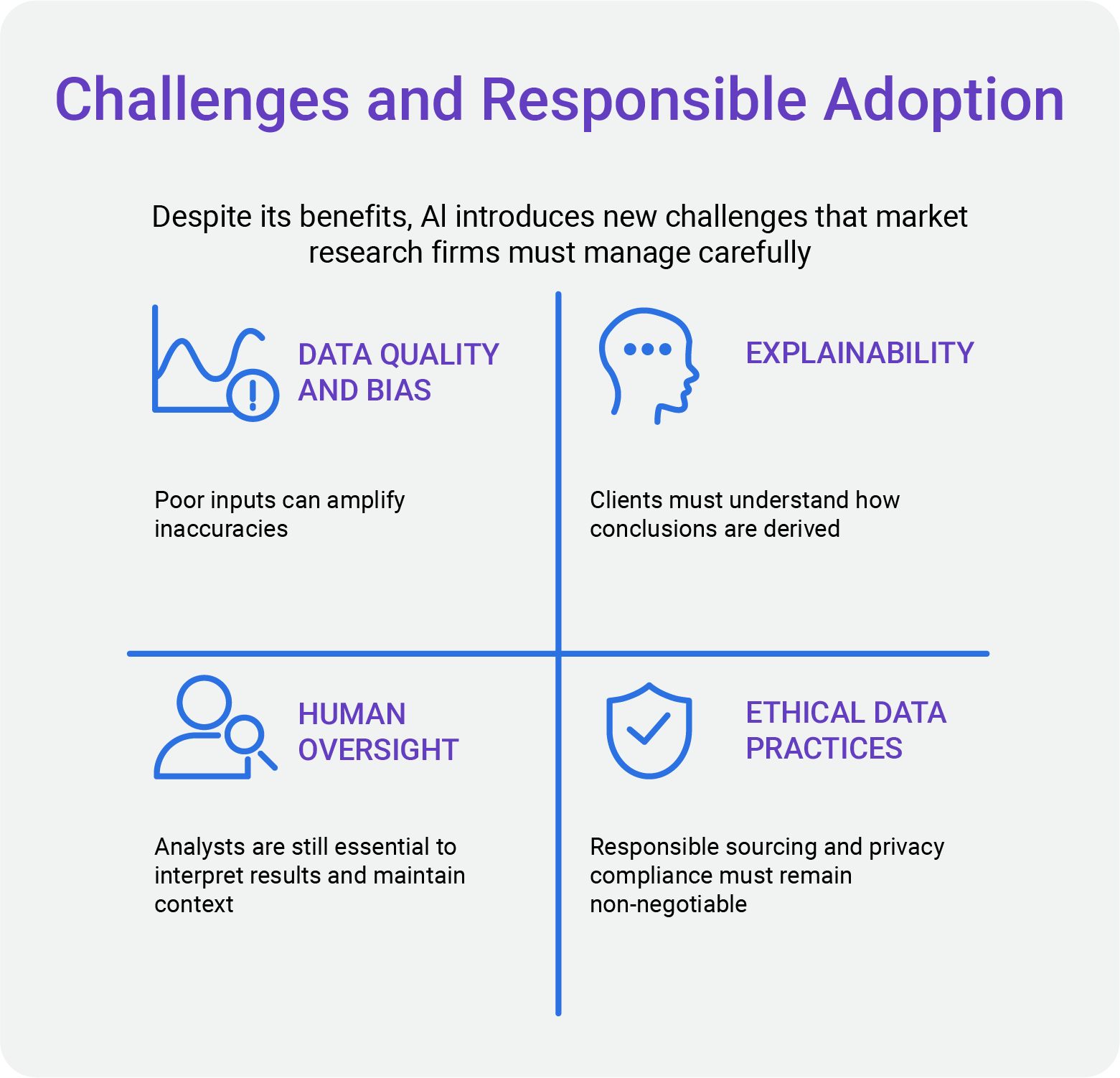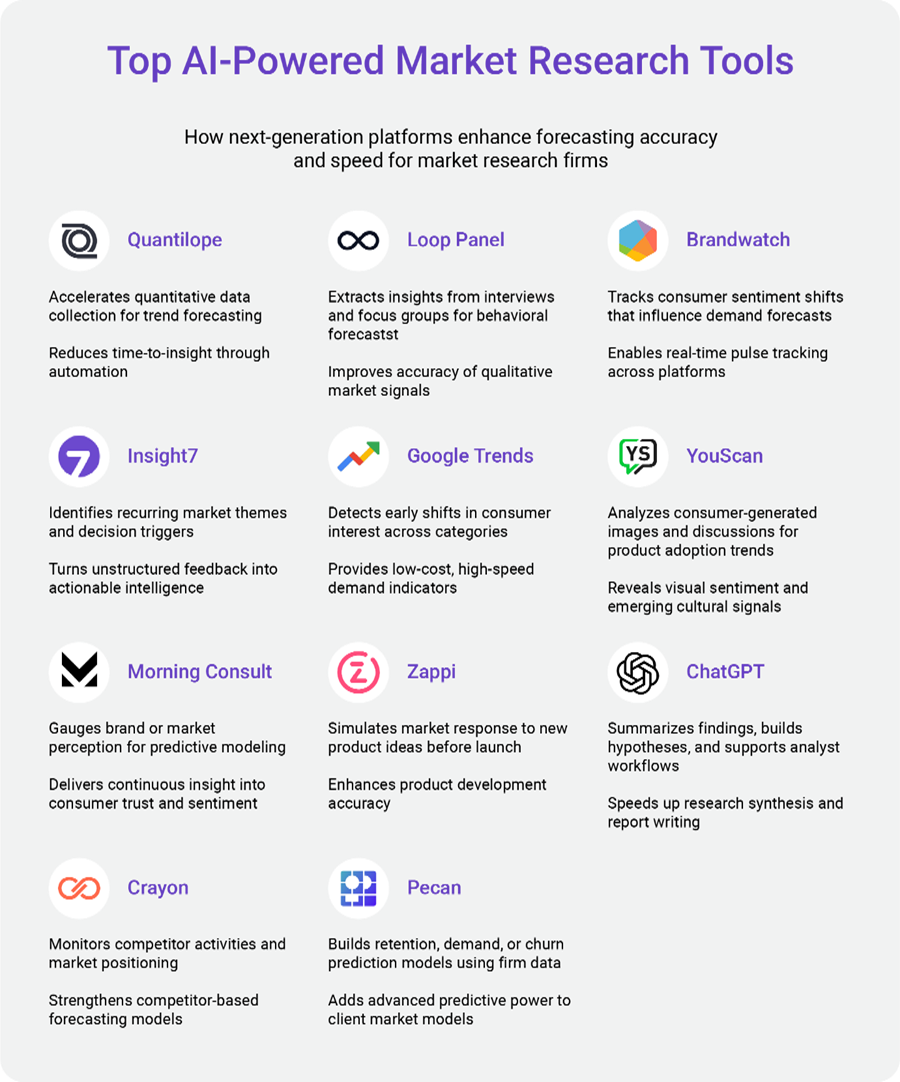Traditional forecasting models can no longer keep pace with the complexity of global trends, shifting consumer behavior, and dynamic industry cycles. Market research firms are increasingly turning to artificial intelligence (AI) and machine learning (ML) to achieve forecasting precision that manual models can’t match.
These technologies are redefining how data is analyzed, interpreted, and transformed into foresight, empowering businesses to make faster, smarter, and more resilient decisions.
Why Forecasting in Market Research Needs Reinvention
For decades, forecasting in market research relied on historical data and static models to project growth trajectories. While effective in stable environments, these methods struggle in markets where change happens overnight.
Fluctuating supply chains, emerging technologies, and global disruptions such as geopolitical conflicts or economic volatility demand a new generation of forecasting models that can adapt in real time.
AI and ML now provide that adaptability. They can process vast, diverse datasets, uncover non-linear relationships, and detect early market signals long before they appear in conventional indicators. This shift enables research firms to deliver forecasts that evolve continuously with the market.
The Limits of Traditional Forecasting Models
Legacy forecasting techniques, such as linear regressions and moving averages, depend heavily on past performance. They work best when markets behave predictably, but modern industries don’t. These methods face several challenges:
- Static assumptions: Models can’t adjust quickly when external shocks occur.
- Human bias: Analysts’ subjective judgment may skew outcomes.
- Data latency: Forecasts take time to update, often lagging behind real conditions.
For research firms competing on credibility and speed, these weaknesses create a growing need for AI-enabled systems that can automate, refine, and validate insights continuously.
How AI and Machine Learning Elevate Market Forecasting
AI and ML allow market researchers to analyze more data in less time while uncovering insights that traditional models overlook. Within market research, three applications are particularly transformative:
Predictive Analytics for Market Trend Detection
Machine learning algorithms identify emerging trends by analyzing both structured and unstructured data from trade statistics to social media sentiment. They can correlate subtle patterns, such as rising online mentions of sustainable packaging or changing raw material prices, with future market demand. Predictive analytics thus helps research firms anticipate inflection points earlier than competitors.
Neural Networks for Non-Linear Forecasting
Unlike standard regression models, neural networks detect complex relationships between multiple variables. For example, Long Short-Term Memory (LSTM) models can analyze time-series data to project demand for electric vehicles or semiconductors under varying policy and supply scenarios. This approach enables continuous learning as new information enters the system, resulting in forecasts that self-improve over time.
Natural Language Processing (NLP) for Sentiment and Policy Analysis
Market intelligence increasingly depends on understanding narrative data including investor calls, industry reports, and government statements. NLP models extract insights from these text sources, identifying tone, intent, and policy direction. This capability helps research firms refine their forecasts with context-aware signals, especially during regulatory shifts or innovation cycles.
How Leading Research Firms Apply AI in Forecasting
Forward-looking market research firms now embed AI into every layer of their forecasting workflows.
Key applications include:
- Automated Model Updates: Algorithms recalibrate forecasts as new data streams in, eliminating manual lag.
- Scenario Forecasting: AI creates multiple demand or pricing scenarios based on dynamic variables, enabling clients to plan for best- and worst-case outcomes.
- Cross-Sector Analysis: By connecting interdependent markets, such as energy, logistics, and automotive, AI uncovers hidden correlations that influence long-term demand.
- Smart Data Integration: AI platforms unify primary, secondary, and syndicated data into a single analytical framework, improving model consistency and transparency.
Turning AI Predictions into Reliable Foresight with Data Triangulation
Even as AI improves accuracy, human validation remains critical. Data triangulation ensures that machine predictions hold up against real-world evidence. In modern forecasting:
- AI detects and models patterns across diverse datasets.
- Analysts interpret the findings and eliminate outliers or false correlations.
- Clients validate assumptions using market feedback or operational data.
Moreover, explainable AI (XAI) frameworks allow researchers to clarify how models reach their conclusions, meeting transparency standards expected in client boardrooms.
Benefits for Research Firms and Clients
AI-driven forecasting strengthens both operational efficiency and client value.
|
For Research Firms |
For Clients |
|
Faster model iterations and updates |
Real-time access to evolving insights |
|
Scalable handling of global datasets |
Higher confidence in strategic planning |
|
Reduced analyst bias and manual error |
More defensible decisions backed by data |
|
Enhanced validation through automation |
Early identification of growth opportunities |
Challenges and Responsible Adoption
Despite its benefits, AI introduces new challenges that market research firms must manage carefully:
- Data quality and bias: Poor inputs can amplify inaccuracies.
- Explainability: Clients must understand how conclusions are derived.
- Human oversight: Analysts are still essential to interpret results and maintain context.
- Ethical data practices: Responsible sourcing and privacy compliance must remain non-negotiable.

The Future of AI-Driven Forecasting in Market Research
By 2026, AI will become an essential layer in every credible market forecast.
We can expect:
- Real-time forecasting dashboards that update continuously as data changes.
- Integration of IoT and satellite data for monitoring industrial production, supply chains, or agricultural cycles.
- Collaborative AI systems that assist analysts by suggesting revisions or detecting anomalies before reports are finalized
This evolution marks a transition from static, backward-looking reports to living intelligence systems that reflect the pulse of global markets in real time.
Top AI-Powered Market Research Tools

Conclusion
AI and machine learning are redefining what accuracy means in market research. The strongest forecasts now emerge from collaboration between analytical algorithms and human judgment. As market complexity grows, firms that combine transparent methodology with intelligent automation will set the new benchmark for credible, data-driven insight.
Kings Research outlines a future in which human expertise and machine-driven precision operate together to produce forecasts that help organizations navigate uncertainty with greater confidence and clarity.





